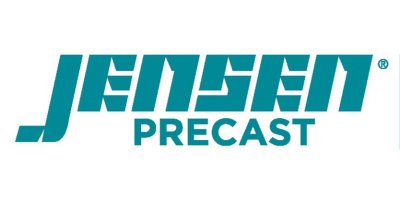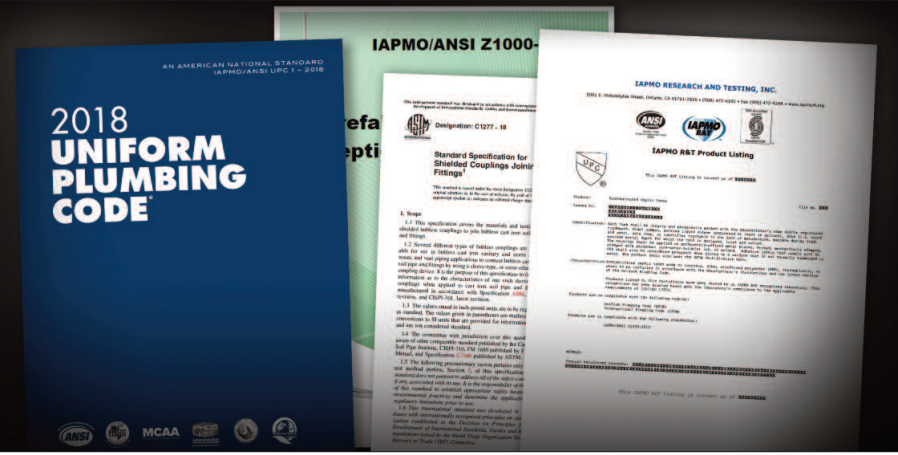First, let’s look at some quick definitions.
CODES
According to the Uniform Plumbing Code (UPC), a code is “a standard that is an extensive compilation of provisions covering broad subject matter or that is suitable for adoption into law independently of other codes and standards.” Codes are generally the top-tier documents, providing a set of rules that specify the minimum acceptable level for manufactured, fabricated, or constructed systems and objects. Codes are frequently adopted by governmental bodies and become legally enforceable.
STANDARDS
The UPC defines a standard as a “a document, the main text of which contains only mandatory provisions using the word ‘shall’ to indicate requirements and which is in a form generally suitable for mandatory reference by another standard or code or for adoption into law. Nonmandatory provisions shall be located in an appendix, footnote, or fine print note and are not to be considered a part of the requirements of a standard.” Standards are documents that establish the engineering and technical requirements of products, practices, methods and operations. Sometimes defined as a set of technical definitions and guidelines: “The How To.”
SPECIFICATIONS
Specifications provide specific and additional requirements for materials, components or services that are beyond the code or standard requirements. Specifications are often a type of technical standard for materials, designs, products or services.
THIRD-PARTY CERTIFICATION
The UPC defines certification as “equipment or materials included in a list published by a listing agency (accredited conformity assessment body) that maintains periodic inspection on current production of listed equipment or materials and whose listing states either that the equipment or material complies with approved standards or has been tested and found suitable for use in a specified manner. Third-party certification is performed by an independent and/or nationally recognized organization that has reviewed the manufacturing process of a product and has independently determined the final product complies with the specific standards and specifications for quality and performance of that product.
Let’s tie all these together to see how codes, standards, specifications and third-party certifications interconnect with each other. For the sake of example, we’ll use prefabricated septic tanks. These products are regulated by the California Plumbing Code (CPC), which is part of the California Building Standards Commission (CBSC). This falls under Title 24 of the California Code of Regulations and thus named Title 24 of the California Building Standards Code. The California Plumbing Code is Part 5 and not to be confused with the Uniform Plumbing Code (UPC). These are state regulations and state law, which can be legally enforced criminally or civilly. These are also top-tier documents that provide all the necessary rules and guidelines for building in California.
As we look deeper into this code (2016 California Plumbing Code), we’ll find Appendix H 501.14 Prefabricated Septic Tanks (1) stating: manufactured or prefabricated septic tanks shall comply with approved applicable standards and be approved by the Authority Having Jurisdiction (AHJ).
Now, lets review the applicable standard(s), where we find in Chapter 17 Referenced Standards, 1701.1 stating: the standards listed in table 1701.1 are intended for use in design, testing and installation of materials, devices, appliances and equipment regulated by this code. These standards are mandatory where required by sections of this code.
Chapter 17 of the 2016 California Plumbing Code contains referenced and accepted plumbing standards included in the CPC. On page 341, ASTM C1227-2013 is listed as the Standard Title for Precast Concrete Septic Tanks; also, on page 352 of the CPC, under Standard Titles we also find IAPMO Z1000-2013 Prefabricated Septic Tanks.
These are the accepted standards as we discussed earlier as the standards that provide the engineering and technical requirements in the construction of prefabricated precast concrete septic tanks — “The How To.”
We’ve discussed codes and standards; now we’ll review specifications. ASTM C1227-2013 is titled Standard Specification for Precast Concrete Septic Tanks; also, this ASTM Standard is fully and completely incorporated into IAPMO Z1000 Prefabricated Septic Tanks. ASTM C1227-2013 is a six-page document that contains all the specifications for the referenced standard, along with more than 25 additional standards and sub-specifications for underlying components, materials and testing procedure. The scope title of this document reads: This specification covers design requirements, manufacturing practices, and performance requirements for monolithic or sectional precast concrete septic tanks.
As stated earlier, third-party certification is an independent review by a nationally recognized organization of the engineering documents and drawings of the product and determines that the final product meets and compiles with the specific standards and specifications of the named product. This review typically includes a thorough review of shop drawings, dimension reviews and compliance inspections. Most certified or listed products bear a nationally recognized certifier’s mark or emblem to represent that product as being third-party tested and certified.
Section 301.2 of the CPC requires that pipe, pipe fitting, traps, fixtures, material, and devices used in a plumbing system shall be listed or labeled (third-party certified) by a listing agency (accredited conformity assessment body) and shall comply with the approved applicable recognized standards referenced in the code. Therefore, third-party certification is a requirement mandated by the codes.
Now we’ll discuss the great benefits that our prior discussion provides to city and county governments and regulators charged with approving waste water products, septic systems and septic tanks in their respective areas of responsibility.
Regulators, city or county governments, usually do not have the resources and staff to perform the necessary product testing, which can be highly specialized; staff that is qualified and knowledgeable to review engineering calculations; resources to all the necessary sub- standards and specifications (over 25 under ASTM C1227) including all current updates; and qualified representatives to inspect manufacturing faculties and production sites.
This is probably not possible by most agencies. However, no regulator, city or county government needs to; it’s all performed by thorough compliance to the prescriptive codes, standards, and specifications, coupled with requiring nationally recognized third-party certification and listing associations (for all manufactured waste water products). These third-party certifying agencies are the best qualified, experienced and poses all the necessary resources to protect regulators, city and county governments, and above all consumers. AHJs rely on their respective building departments to ensure they are best protected by products or services they use that meet nationally recognized standards and specifications.
Only two third-party bodies are ANSI accredited to certify septic tanks — IAPMO and The National Precast Concrete Association (NPCA). IAPMO has been certifying waste water products, along with hundreds of other products, for decades and develops the Uniform Plumbing Code. IAPMO was founded more than 90 years ago, with the mandate “to advance the latest and most improved methods of sanitation; to promote the welfare of the harmony between the owner, the builder and the craftsman; to accomplish a uniformity in the application of the provisions of the ordinances; and to promulgate the mutual benefit of the members.”
The founding members of IAPMO first gathered to begin writing a model code to protect the health of the people they served from inept plumbing practices. There were 39 Southern California plumbing inspectors in the first group in 1926.
IAPMO Z1000, Prefabricated Septic Tanks, has been an ANSI-recognized standard since 2007.
This standard is monitored by the IAPMO Z1000/Z1001 TSC (technical subcommittee), comprised of industry stakeholders including manufacturers, distributors, national
associations, testing laboratories, certification bodies, regulatory agencies, standards
developing organizations, contractors, labor organizations, educators, researchers, and technical societies. The Z1000/Z1001 TSC reports and submits proposed changes to the IAPMO Plumbing Standards Committee (PSC). The Plumbing Standards Committee is a consensus standards development body balanced in accordance with the ANSI Essential Requirements between three interest categories; producer (manufacturer) interest, user interest, and general interest.
IAPMO R&T is North America’s premier plumbing product certification agency and is accredited by the American National Standards Institute (ANSI).
Allowing septic tanks that are not certified under IAPMO Z1000 Prefabricated Septic Tanks places all involved, stakeholders, owners and regulators, in a very precarious position; while adhering to the codes, standards, specifications and third-party certification requirements will always remain the optimum policy and best mandate for all.

Rick Oliver
Last modified: December 21, 2022

